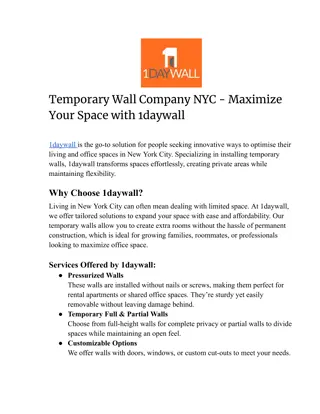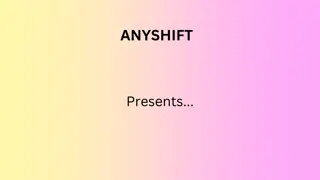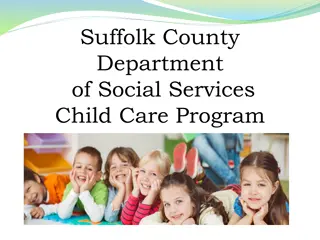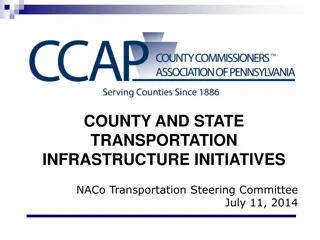Guidelines for Temporary Food Service Operations at Charles County Events
In Charles County, temporary food service operations are defined as facilities operating with events lasting up to 30 days, requiring a permit from the Department of Health. The process involves submitting an application, meeting minimum requirements like proper waste disposal and food storage, and ensuring food is from approved sources. The location must be sanitary, and food preparation guidelines must be followed strictly. Non-compliance risks contamination and foodborne illnesses.
Download Presentation

Please find below an Image/Link to download the presentation.
The content on the website is provided AS IS for your information and personal use only. It may not be sold, licensed, or shared on other websites without obtaining consent from the author. Download presentation by click this link. If you encounter any issues during the download, it is possible that the publisher has removed the file from their server.
E N D
Presentation Transcript
TEMPORARY EVENTS Charles County Department of Health, Division of Environmental Health
Definition A temporary food service operation is defined as a food service facility that operates in conjunction with a fair, carnival, public exhibition, or another similar event for no longer than 30 consecutive days A temporary event permit is issued for the duration of an event at a specific location Food service can occur with or without charge
How do I get a permit? Submit a permit application to the Charles County Department of Health, Division of Environmental Health Services. Please submit application at least two weeks before your event. A minimum of 72 hours is necessary. Provide your tax exempt number if you are bonafide non-profit organization. If you are not fee exempt, submit licensure fee.
What Are the Minimum Requirements? 1. 2. 3. 4. 5. 6. 7. 8. 9. 10. Hair restraints and clean clothes must be worn 11. Liquid and solid waste must be disposed of properly 12. Effective insect and vermin control must be provided 13. Adequate lighting must be provided, if after dark 14. An effective means of ware washing must be provided 15. An appropriate stem thermometer must be provided Food service must be at an approved location Food must be from an approved source Food must be stored at proper temperatures Food must be cooked to proper temperatures Hand washing station must be provided Provide separate areas for raw and cooked food Exposed foods must be protected from contamination Ice and water must be from an approved source Restroom facilities must be provided
Approved Location Acceptable Location Unacceptable Location The site must be sanitary No mud, sewage, standing water, animal contamination, etc. Tents may be erected over grassy areas, cement, asphalt, or temporary flooring.
Food From Approved Source Food may NOT be prepared or stored in a home kitchen. Acceptable sources of food include grocery stores, restaurant supply companies, farm stands (for whole produce only). Seafood, meats, dairy and eggs must be from a licensed, regulated source. Ensure any shellfish (oysters, clams, mussels) is from a licensed shell stock shipper or shucker-packer. Provide shell stock tags on site. Meats and eggs must be USDA approved. Food served has not been recalled and is not past sell by or expiration dates. No severely dented or swollen cans may be used. Home canned goods are not acceptable. Food used may not be adulterated, contaminated, or spoiled.
Proper Food Storage Temperatures Potentially hazardous food must be kept hot or cold Refrigerated food must be 41 degrees or less. Hot held food must be 135 degrees or greater. Pasteurized crab and reduced oxygen packaged products must be stored at 38 degrees or less. Time holding food at a temporary event is not acceptable Frozen food must remain frozen; food that has thawed may not be refrozen.
Proper Cook/Reheat Temperatures Comminuted meats (hamburger, sausage), egg mixtures 155 degrees Chicken, stuffed meats 165 degrees Whole pork, whole beef, seafood, individual eggs 145 degrees Vegetables, rice, potatoes, and other non- potentially hazardous foods cooked for hot holding 135 degrees. Commercially pre-cooked products for hot holding (i.e. hot dogs, canned soup, nacho cheese) 135 degrees, unless package directions state otherwise.
Proper Hand Washing Station Must provide hot water (100-120 degrees F). Hand washing stations must be stocked with soap and paper towel. Hand washing station must be accessible. Potable water must be utilized. Hand sanitizer use is not a replacement for proper hand washing.
Approved Work Surfaces Cross-contamination shall not occur: Separate work surfaces must be provided for raw and cooked food products. Wiping cloths must be stored in an approved sanitizing solution. 50-100 PPM chlorine, or 200-400 PPM quaternary ammonia Utensils must be cleaned and sanitized between uses. Foods stored in coolers should be stored in a manner that prevents cross contamination. i.e. raw hamburgers should not be stored with lettuce, etc.
Protect Exposed Foods No cooking on the ground. Food must be stored off of the ground surface. Coolers containing food must be off of ground Food must not be stored in proximity of waste containers, pesticides, or cleansers. Food must be protected from the weather, i.e. rain.
Ice and Water From Approved Source All water must be from a tested water supply. Located on a public water supply Private well that is tested quarterly and has passed most recent test, such as a church or fire station (check with Health Department) Holding tanks on mobile units must be sanitized often, preferably before every fill up. Any hoses used for water delivery must be potable water/NSF approved hoses. All ice must be from an approved source. From a licensed facility Ice supply company
Restroom Facilities Employee toilet facilities must be within a reasonable distance and must be available during all hours of operation. Reasonable distance Employee toilets should have hand washing facilities when possible. Employees must wash hands when returning from restroom.
Employee Hygiene Food handlers must have clean outer garments. Shirt is required Food handlers must wear adequate hair restraint. Hat, hairnet, bandana Visors may be worn if hair is tied into a pony tail Gloves are worn when handling ready to eat food. Hands must be kept clean. Employees shall not use tobacco in food service areas. Employees may not be ill or have the following symptoms: Diarrhea Open sores Persistent sneezing, coughing, or runny nose. Proper Glove Use
Waste Disposal There must be an approved method of disposing refuse. Provide garbage containers Ensure waste will be transported to appropriate garbage facilities There must be an approved method of disposing liquid waste. Waste water may NOT be dumped on the ground Ensure trash container location does not pose an insect or food contamination issue. Not Acceptable
Insect and Vermin Control Effective vermin and insect control measures must be utilized: Overhead protection is required (with screening on three sides if there is open food or food preparation). Grills outside of the screened area must be provided with a lid. Fans may be used to control insects at serving areas. Doors and windows of mobile units must be kept closed, or screened. Acceptable Tent
Adequate Lighting Adequate lighting must be provided: Lights in food service, preparation, and ware washing areas should be shielded. Lighting only required if food service continues after dusk. Light should be sufficient enough to easily see all areas of food operation Decorative lights (i.e. holiday lights) may not be used around food preparation areas
Ware Washing Containers must be large enough to adequately wash and sanitize largest utensil Must have three basins, dishwashing soap, sanitizer, and appropriate sanitizer test strips Sanitizer concentration at 50-100ppm chlorine or 200-400ppm quaternary ammonia Potable water must be used.
Stem Thermometers Thermometers must be in 2 degree increments and be in the appropriate range for refrigeration and cooking temperatures Examples of appropriate stem thermometers
Cottage Food A cottage food product is a non-potentially hazardous (shelf-stable) food that is sold in Maryland directly to a consumer from a residence, at a farmers market, at a public event, by personal delivery, or by mail delivery; or directly to a retail food store. Cottage foods cannot be offered for sale through interstate commerce. NOTE - Honey (raw unprocessed, unflavored), supplied directly from the farm on which it was produced, is considered a raw agricultural product and NOT a cottage food product. What types of foods are allowed to be produced for sale by a cottage food business? Non-potentially hazardous/non-perishable baked goods, such as bagels, pastries, brownies, cookies, breads, cakes, pies, sourdough breads, etc. made without potentially hazardous toppings or fillings; Hot filled high-acid fruit jams, jellies, preserves, and butters made only with fruits with a natural pH of 4.6 pH or less; Hard candy; Chocolate confections made from commercially manufactured chocolate (e.g., chocolate covered pretzels); Repackaged commercial ingredients (such as tea blends, spice/seasoning blends); Snack mixes from commercial sources (such as cereal, granola, and trail mixes); Non-potentially hazardous snacks (such as popcorn balls, kettle corn, popcorn, and nuts); Whole roasted coffee beans
Cottage Food cont What types of food are NOT allowed to be produced for sale by a cottage food business? Potentially hazardous foods that require any type of refrigeration (e.g., raw or cooked fish/animal products, cooked vegetables, baked goods containing fruit with a natural pH above 4.6, garlic in oil mixtures, cheesecakes, pumpkin pies, custard pies, cream pies, etc.); Beverages of any kind; Chocolate covered fresh fruits (i.e., strawberries, apples) or chocolates made from raw cocoa beans or potentially hazardous ingredients; Dehydrating (or drying) fruits, herbs and vegetables; Fermented foods, acidified foods, or low acid canned foods; Fresh cut fruit of any kind added as an unbaked topping; Flavored or ground coffee; Nut butters and seed butters; Pasta - dehydrating or fresh; Pies - Meringue, Pumpkin & Sweet Potato; Raw dough and energy balls; Raw seed sprouts; Soft candies (such as homemade caramel and fudge); Sugar free products (such as jams, jellies, preserves, fruit butters, and marmalades); S yrups
Cottage Food cont More Information: https://health.maryland.gov/phpa/OEHF P/OFPCHS/Pages/Cottagefoods.aspx
More Information Additional information can be obtained from: www.charlescountyhealth.org























